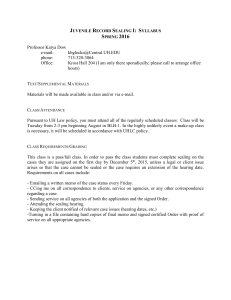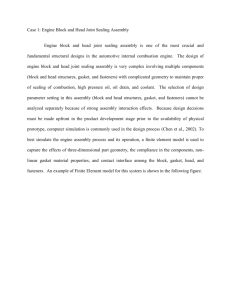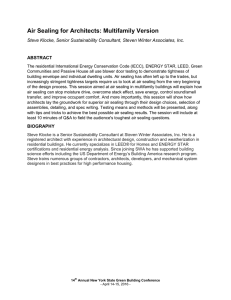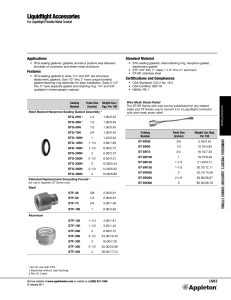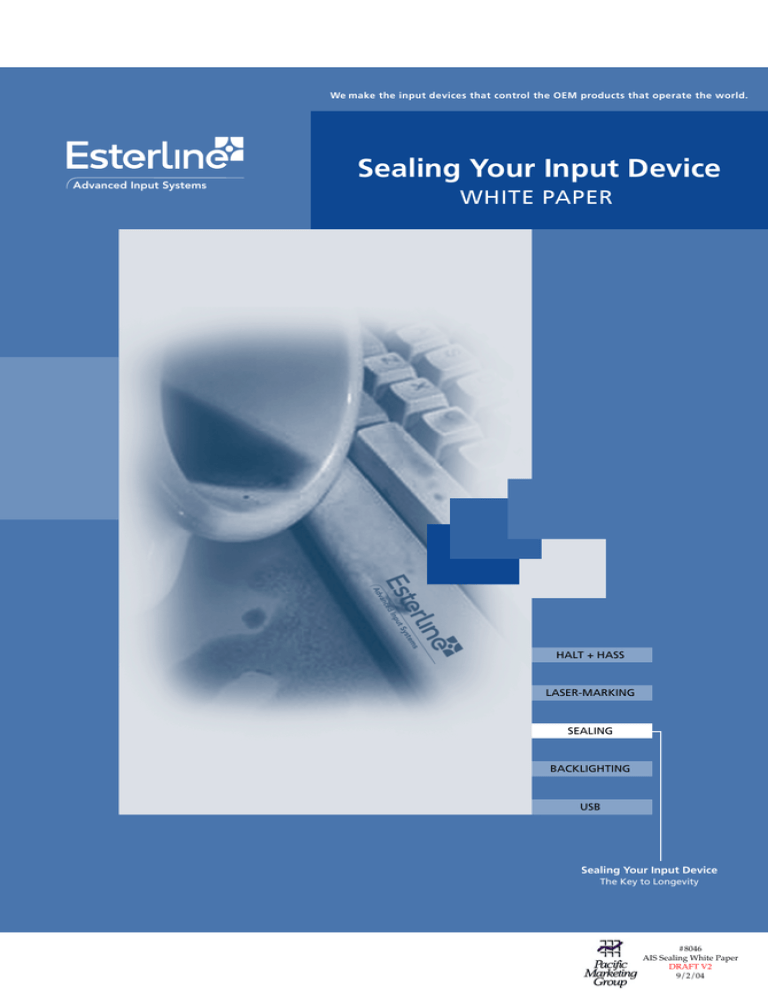
We make the input devices that control the OEM products that operate the world.
Advanced Input Systems
Sealing Your Input Device
WHITE PAPER
HALT + HASS
LASER-MARKING
SEALING
BACKLIGHTING
USB
Sealing Your Input Device
The Key to Longevity
#8046
AIS Sealing White Paper
DRAFT V2
9/2/04
Sealing Your Input Device:
The Key To Longevity
All materials are permeable to some degree. Sealing, therefore, as defined by Advanced Input Systems is to prevent the
egress into an enclosure or layers of a keypad by moisture,
liquids, chemicals, or particles.
Let Advanced Input Systems
render you a sealing solution
fit for your exact use.
Nothing you can do will prolong the life of your input device
more than the proper sealing solution by the above definition.
Primary considerations are the environment in which the
device will operate and the design of the product itself. Our
command of manufacturing, design, material, and technology
produces input devices for the most difficult sealing applications.
An understanding of materials, environments, and products
will help you make the right selection for your device. This
publication describes our most common sealing solutions.
Gasketing
The sealing performance of a gasket material depends
strongly on how it is designed and the environment in which
it operates. Polymeric composites, like those used in gasketing
and sealing applications, consist of polymers combined with
fillers, fibers, rubber, and other materials manufactured on
a calendar under high load. This produces a composite with
interconnected pores. Most commonly, gasket applications
include seals for water, air, gasses, and chemicals.
Materials can be formulated in a wide range of firmness and a
variety of densities. Different materials are carefully engineered
to create a seal in various fluids, operating temperatures,
flange pressures, and mating surfaces. Material uniformity and
consistency of physical properties are crucial when designing to
tight tolerances.
Gasket material is typically supplied in continuous rolls. It is
then easily die-cut, slit, milled, and laminated. The material
can be furnished in ring and full-face flange gaskets as well
as custom shapes. Gaskets are compatible with a variety of
adhesives, allowing for flexibility in positioning.
Environmental considerations vary tremendously between
applications. The most common concerns include compression
set resistance, outgassing, chemical and solvent resistance,
high temperature load retention, low temperature flexibility, thermal conductivity, electrical characteristics, and
coefficient of thermal expansion. Low outgassing and
good resistance to many chemicals and solvents are the
most common considerations when qualifying material for
gasketing and sealing applications.
Most sealing or permeability tests use the same basic
technique. The purpose is to measure the total quantity
of fluid lost over the face and through the body of the
gasket. Leakage rate is the quantity of fluid passing
through the body and/or over the face of a gasket over
a specified time. Working conditions such as media,
pressure, temperature, and surface pressure profoundly
influence leakage rate. For a given set of application
circumstances, the lower the leakage rate, the better
the gasket material retains the fluid.
Gasket pressure under operating conditions is a crucial
design criterion to prevent unacceptable creep relaxation
or failure of the gasket material. The limit on gasket
compression is generally determined by the required
sealing performance. The smaller the quantity of fluid
lost with time, the better the sealability of the gasket
material.
A few common gasket applications for input devices
are as follows:
• A back mounted panel where the gasket is placed around
the topside perimeter and seal is nestled between the
enclosure and the unit. Used in a back mount design,
the gasket can serve a dual purpose as well; one to seal
and one to be an EMI barrier. EMI compatible material
can be used when choosing the appropriate gasket
material for your particular application.
• A top mounted panel set into a recess in a bezel so that
the gasket is around the bottom to prevent leakage. As
the gasket compresses with installation it seals the panel
and prevents liquids from entering.
• A gasket can be designed to be placed around the
middle of two mating surfaces such as plastic halves
which when compressed in assembly seals the unit.
Adhesives
Pressure Sensitive Adhesives
Pressure Sensitive Adhesives (PSAs) are widely used for
sealing input devices. PSAs are generally a layer of uncured
acrylic adhesive that is laminated onto the surface of the
keypad. When installed into the bezel, pressure and
temperature combine to cure the adhesive. This adhesive
acts as a physical barrier to a wide variety of liquids,
chemicals, and particles. It is suitable for use in a wide
range of temperatures and pressures.
Hot Melt Adhesives
Hot melt is designed to protect electronic circuitry and
assemblies from potentially damaging conditions such
as moisture, various corrosive chemicals, excessive heat,
vibration, mechanical impact, thermal shocks and abrasion
which might occur while the device is in operation.
Hot melt adhesives are applied in the molten state and
then harden. The adhesive substance is melted and applied
to the surfaces, which are then joined together. Once the
adhesive cools and solidifies, the joint and seal are complete.
For seal enhancement, a thermal formed plastic sheet can
act as an encapsulate over the hot melt which forces the
necessary encasement of components and achieves a
submergible level of sealing. Hot melt can act as an
electrically conductive adhesive, a sealant, and a coating
— or a combination of all three.
Given the right composite, a circuit board can be submersible without concern for the functionality of the
components. This, of course, depends on temperature
and viscosity.
Other Sealing Technologies
Elastomeric Sealing Bump or Rib
One commonly used technique in a mid travel, back
mount silicone elastomer keypad is to groove the elastomer
tool so as to create tapered sealing ribs or protruding
bumps along the outside perimeter of the keys. Once the
elastomer keypad is back mounted into an enclosure, the
ribs compress and thus prevent liquid from entering the
console. Assembly of components joins the two to prevent
leakage. The seal is formed between the ribs and the
torque load from the back mounted bezel to achieve the
desired level of sealing under the operating conditions.
Silicone RTV
Silicone RTV (room temperature vulcanizing) is similar to
common household bathroom caulking. Silicone RTV is
generally applied to exposed edges or around the
perimeter of a keypad. RTV can accommodate significant
variations in surface flatness and geometries. Selection of
a silicone RTV (or similar two-part epoxy) is dependent
on the material onto which it is applied.
Ultrasonic Welding
Ultrasonic welding is a method of sealing certain plastics
by the use of high-energy sound waves. These sound
waves vibrate specially designed “energy directors”,
causing localized melting of the plastic. A liquid-tight
seal is produced when the plastic re-solidifies.
Conformal Coatings
A conformal coating is a liquid or gaseous chemical that
is applied to “coat” an area or object. When it solidifies,
it prevents exposure to environmental contaminants.
There are two categories of conformal coating – resin
and paraxylylyene. Resins include four different materials:
polyurethane, acrylic, silicone, and epoxide. Paraxylylyene,
referred to as parylene, is a gaseous chemical that is
vacuum deposited to objects. It is typically applied in
much thinner layers than resins. It is highly resistant to
moisture and chemicals, especially organic solvents. Due
to the manner in which it is deposited and its physical
characteristics, parylene is a thin film on top of the object
rather than a covering which flows around it. The coating
used is entirely dependent on the application of the unit
and type of environment from which you are protecting
the device.
For high performance, low cost sealing solutions or
sealability data, contact Advanced Input Systems’
experienced design team. They can help you match
your concepts and technical requirements with the best
sealing solution for your specific application.
For more information, call 1-800-444-5923
or visit www.advanced-input.com
Advanced Input Systems
Advanced Input Systems
600 W. Wilbur Avenue
Coeur d’Alene, ID 83815 USA
sales@advanced-input.com
www.advanced-input.com
We make the input devices that control the OEM products that operate the world.
Common Sealing Solutions
Bezel
Bezel
Gasket
Fasteners
Compress
Gasket
Keypad
PSA
Control
Panel
Gasket
Back Mount
With Gasket
Pressure Sensitive Adhesive (PSA)
With a Top Mounted Keypad
Top Bezel
Ultrasonic
Welded
Joint
er
Low
Bezel
el
Bez
Ultra-Sonic Welded Enclosure
Bezel
Seal
Bumps
Silicone
RTV
Keypad
Keypad Sealed Using Silicone RTV
(Room Temperature Vulcanizing)
Control Panel
Elastomeric
Keypad
Elastomer
With Seal Bumps
Sealing Technologies
Sealing, as defined by
Advanced Input Systems,
Method
Materials
Technology
Protects Against
Expense
Gasketing
Polymeric
Composites
Flat panel, mid
travel, full travel
Moisture, liquid,
chemicals, particles
High
Pressure
Sensitive
Adhesives
Acrylic
Flat panel,
mid travel
Moisture, liquid,
particles
Low
Hot Melt
Adhesives
Epoxy
Circuit boards
Moisture, liquid,
chemicals, particles
Low
Elastomeric
Rib
Rubber
Mid travel,
rubber key
Moisture, liquid,
particles
Low
Silicone RTV
Silicone
Flat panel, mid
travel, full travel
Moisture, liquid,
particles
Low
Ultrasonic
Welding
Plastic
Plastic
Moisture, liquid,
chemicals, particles
Moderate
Conformal
Coatings
Resin &
Parylene
Mid travel,
rubber key
Moisture, liquid,
chemicals, particles
High
is to prevent the egress
into an enclosure or layers
of a keypad by moisture,
liquids, chemicals, or particles.
For more information, call 1-800-444-5923
or visit www.advanced-input.com
© 2004 Esterline Corporation. All rights reserved. Trademarks
and trade names are property of their respective owners.
Advanced Input Systems reserves the right to make changes to
products and services described herein without prior notice.
Advanced Input Systems

